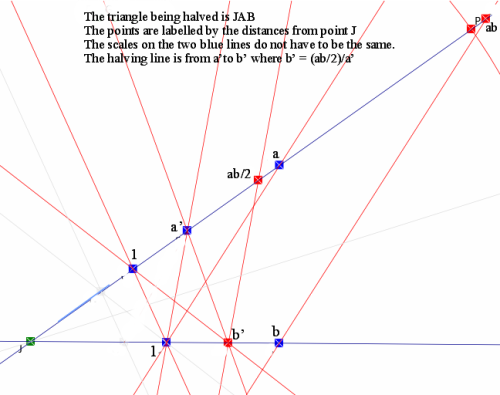While looking at the bisection of area formula (see previous posts)
a’b’ = (1/2)ab
where a’ and b’ are the distances from the vertex of points on the sides of the triangle, and a and b are the lengths of the sides I remembered another formula about triangles, the bisection of the angle formula, with a” and b” being the lengths of the two parts into which the opposite side is divided, namely
a”/b” = a/b
These are like Cuba and Puerto Rico, “Two wings of the same bird”, Jose Marti (in Spanish)
Neither involves the angle itself, and so is very general. I decided that there must be a connection, and after a futile look for some duality in the situation I suddenly saw the connection, in simple algebraic terms:
a’b’ = a’/(1/b’)
and so a triangle with sides a’ and 1/b’ will give a”/b” = a’b’
and then a”/b” = (1/2)ab as well.
This is the construction for the halving a triangle.

This is the extended construction for the bisector. The opposite side is in brown.

and this is a gif showing how as the point a’ (E) is moved the brown line (OE, opposite side) moves parallel to itself, thus preserving the value of the ratio a”/b”
And in case you got this far, some light relief. Bullfrog eats dog food, this morning. The dish is 10 inches across.



The envelope of the lines that halve a triangle is a deltoid consisting of 3 hyperbola arcs. The vertices of the deltoid are the midpoints of the medians of the triangle.
It seems interesting to me to look at the lines (and the associated envelope) that halve the previous deltoid. I would guess it’s a smaller deltoid. Is there a construction that supports/disprove my guess?
Another interesting case is the envelope of the lines that halve a regular pentagon. I am expecting a deltoid with 5 sides.
Great posts and constructions!